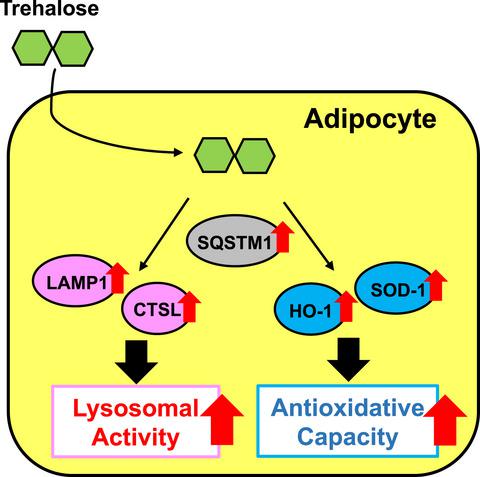当前位置:
X-MOL 学术
›
FEBS Open Bio
›
论文详情
Our official English website, www.x-mol.net, welcomes your
feedback! (Note: you will need to create a separate account there.)
Trehalose induces SQSTM1/p62 expression and enhances lysosomal activity and antioxidative capacity in adipocytes
FEBS Open Bio ( IF 2.8 ) Pub Date : 2020-12-04 , DOI: 10.1002/2211-5463.13055 Masaki Kobayashi 1, 2 , Hiromine Yasukawa 1 , Tomoya Arikawa 1 , Yusuke Deguchi 1 , Natsumi Mizushima 1 , Misako Sakurai 1 , Shoichi Onishi 3 , Ryoma Tagawa 1 , Yuka Sudo 2 , Naoyuki Okita 4 , Kyohei Higashi 3 , Yoshikazu Higami 1, 2
FEBS Open Bio ( IF 2.8 ) Pub Date : 2020-12-04 , DOI: 10.1002/2211-5463.13055 Masaki Kobayashi 1, 2 , Hiromine Yasukawa 1 , Tomoya Arikawa 1 , Yusuke Deguchi 1 , Natsumi Mizushima 1 , Misako Sakurai 1 , Shoichi Onishi 3 , Ryoma Tagawa 1 , Yuka Sudo 2 , Naoyuki Okita 4 , Kyohei Higashi 3 , Yoshikazu Higami 1, 2
Affiliation

|
Adipocytes, which comprise the majority of white adipose tissue (WAT), are involved in obesity‐related pathology via various mechanisms, including disturbed lysosomal enzymatic activity and accumulation of oxidative stress. Sequestosome 1 (SQSTM1/p62) is an autophagy marker that participates in antioxidative responses via the activation of nuclear factor erythroid‐derived 2‐like 2 (NRF2). Trehalose is a non‐reducing disaccharide reported to suppress adipocyte hypertrophy in obese mice and improve glucose tolerance in humans. We recently revealed that trehalose increases SQSTM1 levels and enhances antioxidative capacity in hepatocytes. Here, to further evaluate the mechanism behind the beneficial effects of trehalose on metabolism, we examined SQSTM1 levels, autophagy, and oxidative stress in trehalose‐treated adipocytes. We initially confirmed that trehalose increases SQSTM1 transcription and protein levels without affecting autophagy in adipocytes. Trehalose also elevated transcription of several lysosomal genes and the activity of cathepsin L, a lysosomal enzyme, independently of the transcription factor EB. In agreement with our data from hepatocytes, trehalose induced the nuclear translocation of NRF2 and the transcription of its downstream antioxidative genes, resulting in reduced cellular reactive oxygen species levels. Moreover, some cellular trehalose was detected in trehalose‐treated adipocytes, implying that extracellular trehalose is taken into cells. These observations reveal the mechanism behind the beneficial effects of trehalose on metabolism and suggest its potential for preventing or treating obesity‐related pathology.
中文翻译:

海藻糖诱导 SQSTM1/p62 表达并增强脂肪细胞的溶酶体活性和抗氧化能力
脂肪细胞构成了白色脂肪组织 (WAT) 的大部分,它们通过各种机制参与肥胖相关的病理学,包括溶酶体酶活性紊乱和氧化应激的积累。Sequestosome 1 (SQSTM1/p62) 是一种自噬标志物,通过激活核因子红细胞衍生的 2 样 2 (NRF2) 参与抗氧化反应。海藻糖是一种非还原性二糖,据报道可抑制肥胖小鼠的脂肪细胞肥大并改善人类的葡萄糖耐量。我们最近发现海藻糖会增加 SQSTM1 水平并增强肝细胞的抗氧化能力。在这里,为了进一步评估海藻糖对代谢的有益作用背后的机制,我们检测了海藻糖处理的脂肪细胞中的 SQSTM1 水平、自噬和氧化应激。我们最初证实海藻糖增加 SQSTM1 转录和蛋白质水平而不影响脂肪细胞中的自噬。海藻糖还提高了几种溶酶体基因的转录和组织蛋白酶 L(一种溶酶体酶)的活性,与转录因子 EB 无关。与我们来自肝细胞的数据一致,海藻糖诱导 NRF2 的核转位及其下游抗氧化基因的转录,导致细胞活性氧水平降低。此外,在海藻糖处理的脂肪细胞中检测到一些细胞海藻糖,这意味着细胞外海藻糖被吸收到细胞中。这些观察结果揭示了海藻糖对代谢有益作用背后的机制,并表明其在预防或治疗肥胖相关病理方面的潜力。
更新日期:2021-01-04
中文翻译:

海藻糖诱导 SQSTM1/p62 表达并增强脂肪细胞的溶酶体活性和抗氧化能力
脂肪细胞构成了白色脂肪组织 (WAT) 的大部分,它们通过各种机制参与肥胖相关的病理学,包括溶酶体酶活性紊乱和氧化应激的积累。Sequestosome 1 (SQSTM1/p62) 是一种自噬标志物,通过激活核因子红细胞衍生的 2 样 2 (NRF2) 参与抗氧化反应。海藻糖是一种非还原性二糖,据报道可抑制肥胖小鼠的脂肪细胞肥大并改善人类的葡萄糖耐量。我们最近发现海藻糖会增加 SQSTM1 水平并增强肝细胞的抗氧化能力。在这里,为了进一步评估海藻糖对代谢的有益作用背后的机制,我们检测了海藻糖处理的脂肪细胞中的 SQSTM1 水平、自噬和氧化应激。我们最初证实海藻糖增加 SQSTM1 转录和蛋白质水平而不影响脂肪细胞中的自噬。海藻糖还提高了几种溶酶体基因的转录和组织蛋白酶 L(一种溶酶体酶)的活性,与转录因子 EB 无关。与我们来自肝细胞的数据一致,海藻糖诱导 NRF2 的核转位及其下游抗氧化基因的转录,导致细胞活性氧水平降低。此外,在海藻糖处理的脂肪细胞中检测到一些细胞海藻糖,这意味着细胞外海藻糖被吸收到细胞中。这些观察结果揭示了海藻糖对代谢有益作用背后的机制,并表明其在预防或治疗肥胖相关病理方面的潜力。











































 京公网安备 11010802027423号
京公网安备 11010802027423号